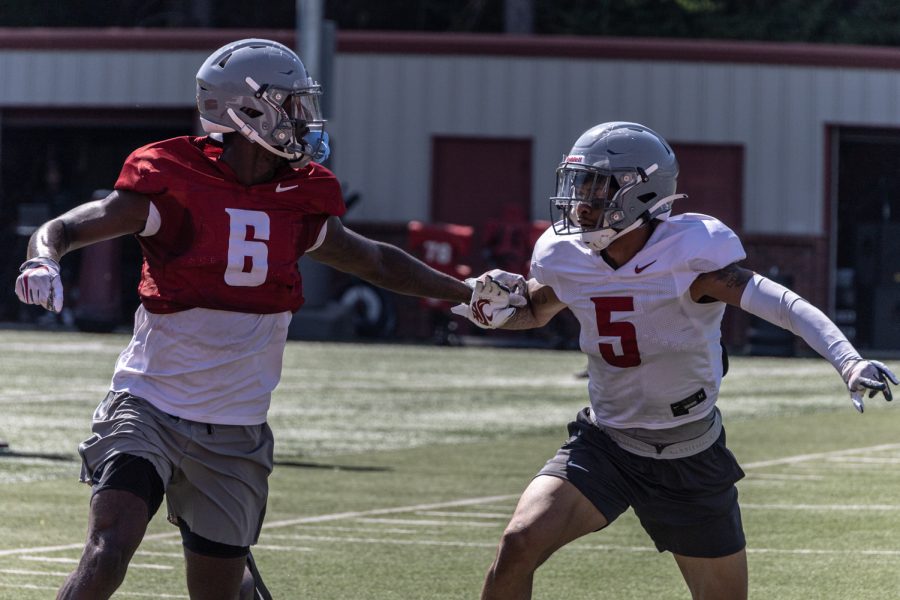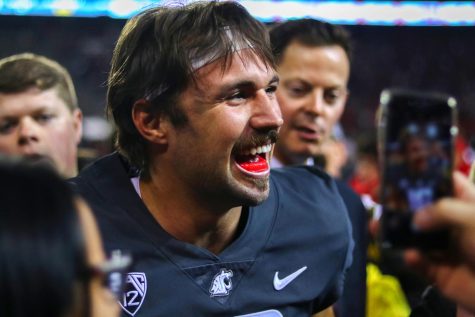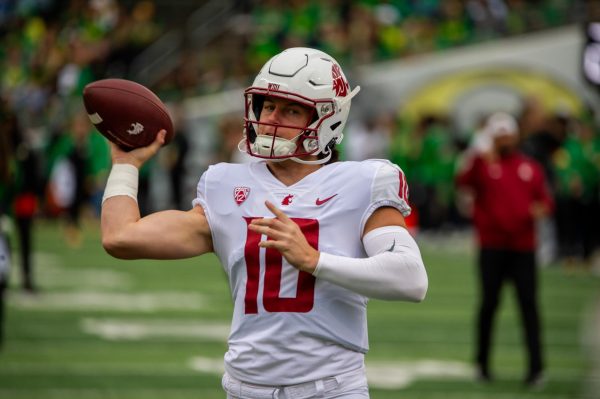Cougar football prepares for 2021 season
Defense looks to be highlight of WSU team; three-man quarterback battle heating up
Redshirt sophomore receiver Donovan Ollie and senior defensive back Derrick Langford Jr. compete on a pass route during an Aug. 16 fall camp practice at Rogers Field in Pullman.
August 19, 2021
This last year has been a frustrating one for Cougar football.
Not only was the Cougs’ schedule drawn and quartered by the pandemic, but the four games the Cougs did play weren’t the most inspiring football the Palouse has seen in the last few years.
The team flashed some promise but had trouble closing out games. The pass defense was porous, giving up over 300 yards a game. The offense had trouble staying on schedule. The Cougs were a young team learning a brand-new system that played like a young team learning a brand-new system.
This year, they have had a chance to play together more. They are more experienced, and they are bigger and stronger. There are also a lot more of them.
The Cougars are projected to field a roster of 118 players this season, which is a lot. In fact, that number is so big that the team was forced to abandon their recreational room so they could install enough lockers for the entire roster. It should go without saying that, barring any major COVID-19-related issues, WSU should have no trouble fielding a full roster week to week.
Many of these additional players are returnees from last season who were granted an additional year of eligibility after the pandemic effectively wiped out most of last season. As such, the Cougs’ projected starting lineup consists largely of familiar faces, with a light sprinkling of younger talent.
“I think the vets have really taken [the younger players] under their wing,” head coach Nick Rolovich said. “It’s almost like we’ve got an extra set of coaches.”
It might be somewhat unfair to evaluate Nick Rolovich and his coaching staff on their previous track record; indeed, it is hard to say that we have seen a proper game in the Rolovich regime thus far. That said, the Cougars were expected to be a feisty team last season, and they finished with a disappointing 1-3 record.
Important to note, however, is that gauging a coaching staff starting a true freshman at quarterback can be difficult, doubly so in a global pandemic that restricts a coach’s ability to install a new scheme. With that in mind, this season will be Rolovich’s first real chance to prove himself as WSU’s new head football coach.
Few would argue the idea that the quarterback is the most important position on the field on any given play, and the Cougs have a trio of very different quarterbacks that Rolovich is tasked with ordering on the depth chart.
Sophomore Jayden de Laura has already made himself a household name among WSU faithful, though perhaps not always for the reasons coaches and fans appreciate. He is without question the most dynamic quarterback on the roster and an ideal option quarterback, as well as a fearless passer with no qualms about fitting the ball into a tight window. He looks to be the front-runner for the starting job.
Graduate student Jarrett Guarantano transferred to WSU this year after a rough tenure as the Tennessee Volunteers’ starting quarterback. Rolovich has lauded Guarantano for his pocket presence and maturity in training camp. He also brings some speed to the table, though he isn’t as elusive as de Laura.
The dark horse in the quarterback competition is undoubtedly Cammon Cooper, the towering left-handed junior who has flashed impressive arm talent and a penchant for scrambling out of danger but has exhibited some inconsistency in training camp.
Whichever quarterback wins the starting job out of camp will profoundly affect how WSU’s offense looks this year, as all three have very different styles that will shape how the Cougs move the ball, especially in key situations.
Rolovich said he plans to evaluate the three quarterbacks primarily on their ability to command the offense. The general feel around training camp seems to be that the job is likely de Laura’s to lose.
If quarterback is the biggest gamble the WSU coaching staff will make this training camp, then the halfback group is where they are playing with house money.
Senior Max Borghi is the unquestioned leader of this position group, one of the best halfbacks in all of college football and arguably the heart and soul of the team. Already established as a multifaceted playmaker in Mike Leach’s offense, he will get the chance to assert himself in a more traditional role this season.
Borghi sat out most of last season, however, and senior Deon McIntosh took the reins in his stead, offering a quicker, more elusive style while averaging a staggering 6.2 yards per carry. He figures to be the primary change-of-pace back this season.
Not to be overlooked, transfer junior Nakia Watson spent most of his time at Wisconsin playing second fiddle to Jonathan Taylor. The 227-pound Watson has been a training camp darling, and he could find himself competing for carries in short-yardage situations this season if he continues his torrid pace.
“Nakia has adjusted incredibly … he’s been fantastic,” Rolovich said.
The receiver corps has been complicated significantly now that star receiver Renard Bell has been ruled out for the season with an ACL tear. In the new Cougar offensive system that emphasizes receiver-heavy formations with multiple slot receivers (WSU does not list a single tight end on their roster, for reference), there are now two starting receiver jobs open for the taking.
The Cougars will look to Travell Harris and Calvin Jackson Jr. to be their top receivers this year, but beyond that lies a goulash of receivers all looking to claim a piece of the offense. From veterans like transfer senior CJ Moore and junior Brandon Gray to training camp standouts, such as freshman De’Zhaun Stribling, sophomore Joey Hobert and sophomore Donovan Ollie, there are a lot of regular-season snaps that have yet to be claimed.
“We [have] got to have a threat out there [on the perimeter] that people are concerned about,” Rolovich said.
WSU returns four starters on the offensive line this season. Most notably, Liam Ryan and Abraham Lucas are mainstays from the Leach years and are both expected to be among the best pass protectors in the Pac-12.
Jarrett Kingston, Cade Beresford and Brian Greene will likely make up the interior of the line. Kingston and Beresford are both taller than the typical guard, standing at 6-foot-5-inches and 6-foot-7-inches, respectively. Both are road-graders that should open up lots of lanes in the run game. Greene is a much more prototypical center with a diverse skill set.
The offensive line has spent much of training camp looking solid and looks to be a strength of the team this season.
The defensive line consists of a host of veterans in the front of the rotation. Willie Taylor, Ron Stone Jr. and Brennan Jackson will rotate in at defensive end, and all of them have flashed impressively as pass rushers in training camp. As a unit, they are very quick and could give larger, slower offensive lines major issues on passing downs.
Ahmir Crowder, Amir Mujahid, Christian Mejia and Dallas Hobbs will likely be the biggest contributors on the interior. They are a smaller, faster group of defensive tackles that will likely be better against the pass than the run and could cause some trouble for quarterbacks in long-yardage situations.
A position group with a few veterans and a lot of youth behind them, the Cougar linebackers are unquestionably led by three upperclassmen.
Jahad Woods and Justus Rogers are well-built, sideline-to-sideline thumpers. They close gaps in the run game like few others in the nation and operate in zone coverage very well. The two of them should assume the majority of snaps in Rolovich’s 4-2-5 scheme, and their play will likely dictate the strength of this defense. Travion Brown is a longer linebacker with a little more to offer as a pass rusher and could also figure in as a blitzer on late downs.
Of all the position groups there are on a football field, WSU’s defensive backs have made the most noise in training camp this year, both figuratively and literally. Jaylen Watson has been the star of camp. He has been generally tough to separate from and is a terrifying hitter in the open field. Watson, among many others, has made a number of very loud, impactful plays.
“That’s the number of passes I want caught on me each game. Zero. I don’t want to give up anything,” Watson said when asked about the reason behind his uniform number.
Derrick Langford Jr. is just as long as Watson, standing at 6’3”, and is a fantastic playmaker in his own right. While he hasn’t shown quite the penchant for curb-checking unwary receivers that Watson has, Langford has been just as productive in coverage this camp.
George Hicks has spent his WSU career playing cornerback but has made the transition to free safety this season. A cerebral player with good ball skills and anticipation to pair with a naturally athletic frame, he looks to be a great fit for the position.
At strong safety, Daniel Isom makes his return to the position he played as a junior. Isom isn’t the hulking specimen that some box safeties are, but like Hicks, his ball skills, speed and fearlessness over the middle more than make-up for any perceived lack of size.
Kaleb Ford-Dement transferred to WSU this year, but his versatility and nose for the ball have found him in great positions throughout camp, and he has a couple of interceptions to show for it.
On the scheme side of things, Rolovich enjoyed great production as a quarterback in June Jones’ run-and-shoot offense in the mid-2000s. He has since adopted that scheme as a coach and has had success with it, turning in double-digit wins in his last season at Hawaii.
The run-and-shoot has found some historical success with mobile quarterbacks. Though de Laura is unquestionably the fastest, most explosive quarterback on the roster, any of the three presumed options at quarterback would be just fine running an offense that expects them to make plays with their legs.
The run-and-shoot is also generally a more complex offense than Leach’s air raid system, which itself is a simplified version of the run-and-shoot, in a sense. The traditional run-and-shoot has more moving parts: more routes, more blocking schemes and more run designs, which could prove more challenging for the offense to learn.
On defense, Rolovich’s 4-2-5 defense meshes very well with the personnel he has. The defensive line plays fast and pressures the quarterback well, the linebackers fly all over the field and play both pass and run effectively, and the defensive backs swarm to the ball.
The Cougars lack a true nose tackle with the size to command consistent double-teams in the run game, and teams that run more pro-style offensive schemes could take advantage of that.
The Cougs’ schedule this season starts with two home games against Utah State and Portland State before No. 15 USC comes to town. From there, the schedule gets progressively more difficult, with road trips to No. 24 Utah and Cal followed by a stretch of three at home against Oregon State, Stanford and BYU.
Capping off the season, the Cougs will have road trips to No. 25 Arizona State and No. 11 Oregon, senior night against Arizona, and will close out the season in Seattle against No. 20 Washington for the Apple Cup, which the Cougs will look to claim for the first time since 2012.
Many pundits have penciled Arizona State in as a dark horse to win the Pac-12, and Utah and Stanford could both potentially be tough matchups for the Cougs; both teams tend towards run-heavy attacks that could wear down WSU’s front seven.
The home game against BYU seems not to be as tough a matchup as it would have been last season, but the other Cougars are never a team to be taken lightly by anyone.
Having both Oregon and USC on this year’s schedule is a tough draw for any team, and Cal has put together a defense that could be exceptionally difficult to move, especially in Berkeley, California. Throw in Utah State as a consistently scrappy team, and this has the makings of a difficult schedule for the Cougs this year.
This WSU team will likely be a difficult one to judge week to week. They boast a stronger roster than they have had in recent years, and for the first time in what seems like ages, the defense will likely be the team’s primary strength.
However, this Cougar team is also very young in the passing game, so moving the ball consistently could prove to be challenging, especially against some of the stronger teams in the Pac-12.
The upside is this WSU team seems to be limitless. If their offense clicks into place early and finds the trademark run-and-shoot explosiveness, they could very well find themselves looking at a top-25 ranking. It is not a certainty that they put it all together this year, but if they win the majority of their games in October, starting with their road trip to Cal, this could have the makings of a very dangerous team.


















